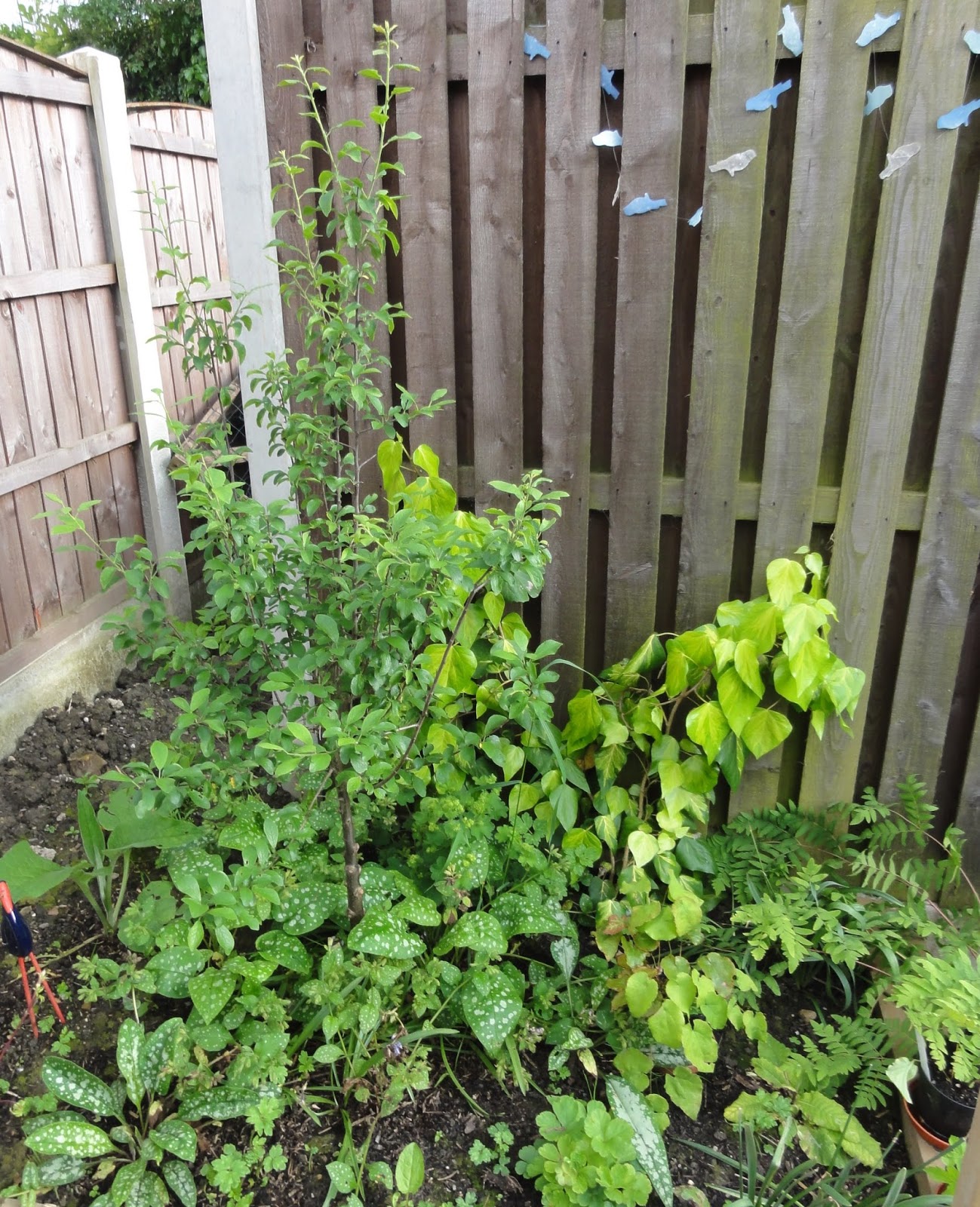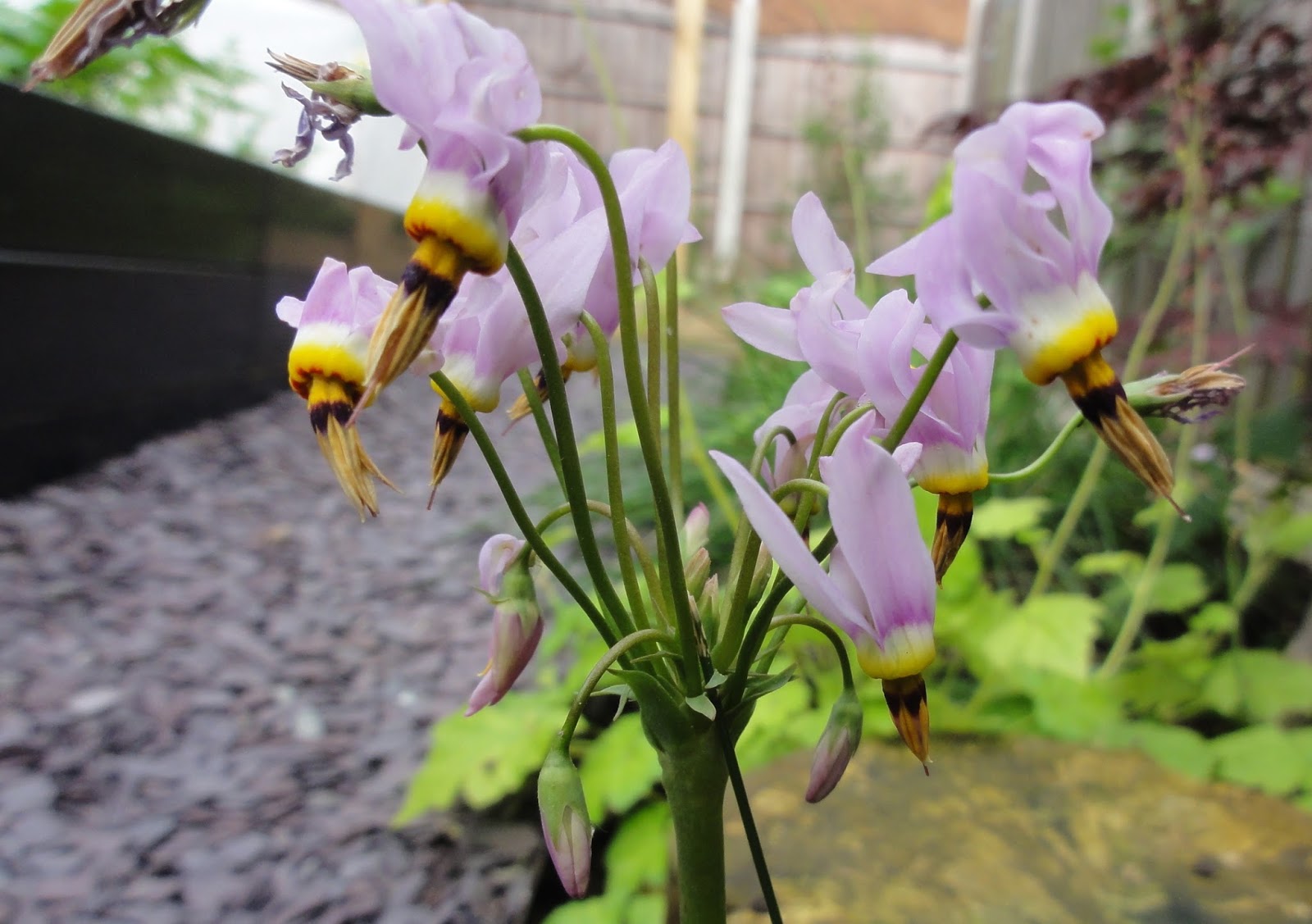Well yes, I am a bit late for EOMV, but my excuse is that I was in Paris at then end of May and beginning of June, so am late. Not a bad excuse eh?!
I’m still very (ME) tired from the holiday, and since this won’t pass for a few days, I’ve decided to mainly do a EOMV in pictures. I do have one specific area I will talk about (see Waterlogging, below), and am hoping for feedback and advice from my lovely fellow gardeners and bloggers. *hopeful face* (as we say on Twitter).
So here goes, the garden at the end of May (ok, 3rd June) 2014.

Overview from left side of garden.
Strawberry bed with lots of green strawberries, holding off for Wimbledon I expect.
Herb Border, rather dominated by the Chives from this angle.
But I do love the chives, as have the bees!
Alternative view of the Herb Border.
Geranium Ann Folkard (above) and Geranium x riversleaianum ‘Russell Prichard’ (recently purchased from Stillingfleet Lodge Nurseries), at the end of each of the long veg beds. They have a trailling habit so I hope they will grow down the raised bed frames to give a more attractive view.
The broad beans have gone completely mad (above), but I suspect this is reducing the
growth of the garlic planted underneath, so they won’t be looking like the healthy garlic below
which isn’t competing with anything else. A learning point for next year.
The young greengage is developing lots of growth (above)
and the comfrey (bocking 14) is now flowering.
The Damson Border is very green. I need to cut back the pulmonaria
now that it has finished flowering to encourage new leaf growth.
Waterlogging
Back in
January’s EOMV I mentioned that I had discovered that one part of the Shady Border suffers from waterlogging. Despite my earlier fears that the bulbs etc wouldn’t flower there, they did. However, that was when the water was only sitting there for a week or so. With recent heavy rains, the soil is so waterlogged that it’s been pretty much like this for several weeks:
Waterlogged
The water extends further along the border than this but I found it harder to photograph. I’m not sure what to do with this section of the Shady Border. Plants that are getting waterlogged include (to name just a few): Geranium phaeum ‘lily lovell’, Polemonium caerulem, several Heuchera, Acer Palmatum ‘Sango-kaku’, Astrantias and Amsonia tabernaemontana.
Whilst they might be able to tolerate moist soil, frequent saturation is a different matter. Will the plant roots die off from excessive water? Should I take any particular plants out that don’t like to be too wet and put them in containers until I decide on a new place to plant them? Would it be better to replace the current planting with ‘bog garden’ type plants? Or should I wait and see what happens with the plants in that section?
I’d be grateful for any advice you have. I’m currently torn between panicking and trying to be calm and see what happens.
So, finishing with what is flowering or looking good in the Long Shady Border…
Even though I only planted it a the beginning of January, the Morello Cherry is producing some fruit!
View from the back of the Shady Border looking towards the house.
Tellima, not sure what variety.
A Polemonium variety brought back from Tibet by Chris Chadwell with pinky-apricot flowers. I picked this up at the HPS plant sale and need to find out what the variety name is, if it has one.
So that’s my May 2014 EOMV. I look forward to catching up on what has been happening in the gardens of other bloggers.
UPDATE 5th June re waterlogging: I’ve spoken to the RHS and they advise that I dig up the Acer immediately as it won’t take being waterlogged and could already be dying. They think that most of the perennials should be ok though, and just want & see what happens. Thanks to the people who commented on this. If it wasn’t for your comments prompting me, I may have left the Acer in the ground. Thanks!
* * * * *
End of month view is hosted by Helen Johnstone, aka @patientgardener. Visit Helen’s blog for her May 2014 EOMV and links to other bloggers EOMV posts.
























I love your herb bed – you've lots of other gorgeous things happening, but for me the herb bed sticks in my mind. And my camassias are long gone, how come yours is still doing its thing? I shall go and grumble at mine immediately…
Waterlogging – hmm… In your place, I'd be thinking about lifting the plants and potting them up; if you leave them in you might lose some (the Acer, almost for sure). Once the plants are out I'd have a go at digging to investigate exactly what the problem is / trying to address it somehow, probably by installing some sort of drainage system, but that's not exactly straightforward – I had to do it once, and it did work, in my last garden. I've got some pretty wet patches now but nothing as bad as that. How clayey is it, and how big an area is involved? (I'm not sure that just digging in lots of grit and organic matter would do it – they sorted mine out, but it was never that soaking.) Sorry to witter on!
Hi Beangenie,
Thanks re the herb bed. Re the Camassia's, a bit of a cheat. That one I just picked up at a nursery a couple of weeks ago and planted as it was about to flower. I do have others that are getting ready to flower elsewhere; I planted my bulbs very late (mid-Jan) so they are still catching up.
Our soil is, well not soil, but incredibly heavy clay, almost potters clay. We did dig a couple of feet out and added the same in compost last year. And each time I add a plant, I dig out a big hole and remove more clay, and add grit/sand before planting. However, that part of the garden is kind of the merging point for two slopes, which makes fixing a bit difficult. Partly as they are sloping the 'wrong way' and to try and drain it would mean going uphill…
I appreciate the witter – it is helpful to get other peoples views. I only planted the Acer in Spring, before all the recent rain. It's more on the edge of the worst waterlogged bit. Maybe you are right and I should dig it up, I just don't know how much it can take before it gets affected. It just occurred to me that maybe I should make the most of my RHS membership and actually call them for some advice…
Looking good. Love that Dianthus, and Dryopteris erythrosora is one of my favourite ferns.
I am still learning a lot about working with wet soil and wondering myself how best to proceed given the vagaries of our climate. Heucheras don't do well for me here, a shame because I love them, and I wonder if that's down to the wet. They like moist but well drained soil. We too garden on clay. Right now I could have moisture loving plants all over, but when the sun comes out the soil goes rock hard in a couple of days.
Paris sounds great, take it easy now.
I'm so glad I ignored the advice telling me to drain a very wet area in the garden here. The previous people planted "ordinary plants" and one by one they died, it turned out we have an underground stream. This area is now our bog garden and even though I do say it myself, it looks lovely! My latest header photo and most recent post shows the plants that can be used, so yes, I would say pot up your plants, especially the Acer, you don't want to lose that!
Hi, how lovely to see your garden, my first visit here. I love your raised beds, I could really do with some of them! I read your post about ME and I can fully sympathise with your situation. I have a very long list of health issues myself, one of which is fibromyalgia, a similar condition to ME. I run my life very much by the principles of pacing and after 20 years on sick leave I have no prospect of ever getting back to any sort of normality. I enjoy whatever the day can give me, and my garden keeps me sane. Literarily.
Hi Rusty Duck, yes the soil here dries v. quickly and is v. hard once the sun comes out. Am starting to think that I'm going to have to change the planting to in this section to plants that can adapt to changes in the soil. If those exist?!
Thanks for visiting Helene. The raised beds were a bit of an investment, but worth every penny if you ask me. Much easier to garden on those compared to the flat beds, so less energy used.
It sounds like your Fibromyalgia is much worse than my ME. I have moderate rather than v. bad ME, so am able to do a bit more, but do have to pace myself. If I couldn't garden though, I don't think I could stand life, so I do work carefully at managing my energy. Like you, the garden keeps me sane.
I enjoyed your EOMV post, and love those roses – so many beauties!
Hi Pauline, the waterlogging wasn't clear until after I redesigned and had the landscaping done. Shows that even after a year of careful observation you don't always see all the potential problems. Also, we didn't have the same levels of rain last year…
I think I'm going to have to carefully research each plant in the waterlogged area and & work out what can cope with it and what needs moving. The acer is actually one of two in the garden, both of which are my partners – his only two plants in the garden! So I definitely want to look after that. It's also more expensive to replace than the others.
Was going to suggest moving the Acer but see the RHS gave you the same advice. I'd be inclined to lift the Heuchera too – I speak from experience. They don't like the waterlogging one bit!
I'd be inclined to wait to see what happens. I had a similar occurance a couple of years back and lost almost everything in the one bed. I promptly replaced them with moisture lovers and although they are all doing well – the flooding hasn't reappeared and I'm having to water a bit more than I'd like!
You could of course turn it into a bog garden by digging deep and laying a pond liner with holes in for drainage. I've seen that done elsewhere and it apparently works well. Good luck with it.